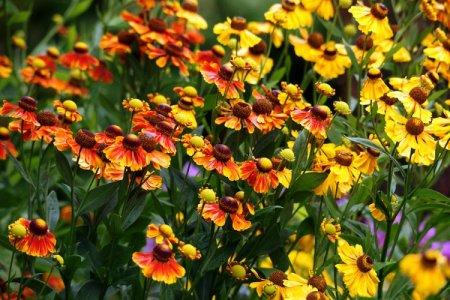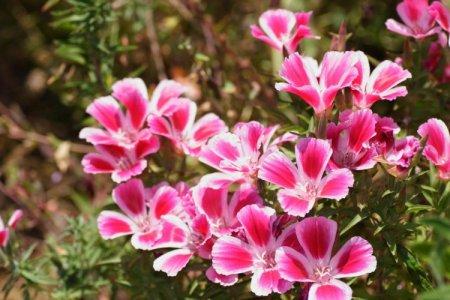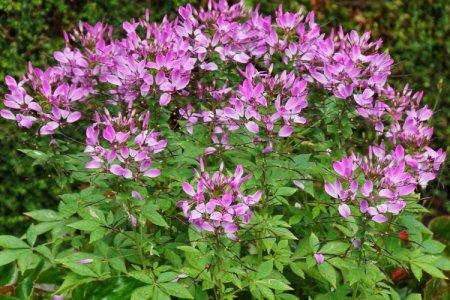
Lush inflorescences of physostegia at first glance seem to be ordinary spikelets. But after looking closely, you will never again confuse them because of the volumetric cylindrical shape and the interesting appearance of the buds themselves. Let's tell you more about this outlandish plant!
general information
The name of physostegy can literally be translated as something like "a bubble under the cover." And all this is due to the convex shape of the cup of the buds. By the way, such original elongated inflorescences are correctly called pleichoasias. Physostegia blooms in August and pleases until frost.
This herbaceous perennial came to us from North America, and has already perfectly adapted to the conditions of the middle zone. The height of the shoots ranges from 60 to 120 cm, and they always have an unusual tetrahedral shape.
The rhizome grows rapidly and intensively. The edges of the leaves are carved and uneven, and the shade is often quite light. The shape of the buds slightly resembles a daylily, and the length of the inflorescences reaches 35 cm.

Types of physicalostegia
According to different classifications, the genus of physostegy has from 3 to 12 species, as well as their decorative forms. Only virgin physicalostegy is cultivated in the garden. Let's dwell on the most interesting varieties.
Physostegia Alba
As you might guess, this is a snow-white variety. It is distinguished by very dense inflorescences, large flowers and shoot height up to 80 cm.

Summer Spire
All lovers of pink flowers will definitely appreciate this variety. You still need to look for such a rich color, but against the background of dark leaves, it seems much brighter.

Rose Bouquet
One of the most original varieties due to the beautiful lilac shade of the buds. And also - one of the tallest, because the height of the shoots reaches 1.2 m.

Physostegia Variegata
Spectacular and tall variegated variety up to 95 cm in height. She has increased immunity, lodging resistance and bright pink flowers.

Physostegia Vivid
Relatively compact form up to 60 cm in height. She has light green leaves and delicate pink flowers.

Physiostegy care
Physostegia is in great need of high humidity. Otherwise, it is completely problem-free, and it takes root and grows just at the slightest contact with the ground!
Temperature and lighting
Physostegia is not afraid of cold weather, but prefers warmth. She needs a sunny area or, in extreme cases, a light openwork partial shade. In the shade, the flowers fade, and the shoots develop poorly. An excellent choice is to plant tall physostegs along walls and fences.

Watering
Watering must be plentiful and systematic. But they always carefully loosened the soil so that the water does not stagnate too much. Due to the superficial root system, loosening must be done very carefully.

The soil
Physostegia is the rarest plant that not only does not rot in moist moist soil, but rather needs it. Loam, sandy loam, black soil - all this is no longer so important. Dig up the ground with peat or compost before planting.

Fertilizers and feeding
Fertilize the physostegia before planting in the garden with regular liquid fertilizing. Apply fertilizer for the flowering plants a second time during the bud formation period. An unpretentious flower doesn't need anything else.

Wintering
Physostegia after flowering is cut off, leaving 10-12 cm of shoots. And in general, this is all preparation for wintering, because most varieties do not need shelter. If you need seeds, collect them in advance, around the end of August. When shelter is still needed, the bush is cut even more - up to 5 cm, and mulched with a torus with sawdust or spruce branches.

Transfer
Physostegia is a perennial that has been growing in one place for years. But once every 5 years, it should still be transplanted to improve its decorative properties.To do this, cut the plant in the fall, dig up the roots, transplant to a new place, field the plot and mulch with sawdust and leaves.

Planting and reproduction of physicalostegia
Physostegia seeds sprout well, so they can be planted in the ground right after harvest. If you want to germinate a flower using seedlings, they do it in March. After 2 weeks, the first shoots appear under the film with periodic watering.
After the appearance of the second leaf, the seedlings dive with a distance of up to 10 cm between them. A couple of weeks before transplanting into the garden, start hardening the seedlings by taking them outside for several hours. Physostegia is transplanted into the ground at the end of May with a distance of up to 30 cm.
In spring, the plant is propagated by dividing the rhizome. Also, the procedure can be carried out at the end of summer at the same time as pruning and transplanting. And at the beginning of summer, cuttings of 10-12 cm take root well. It is better to root them in a container with sand in a cool dark place, and plant them in the garden in the spring.

Pest and disease control
Most often, physostegia suffers from the invasion of aphids. It can be fought with insecticides or decoctions of fragrant herbs. Very rarely, a fungus develops - and then you also cannot do without special preparations. Otherwise, there are no problems with this plant!

Physostegia - photo
Physostegy looks best in the form of large plantings or as an element of multi-level flower arrangements. Just look how good she is!

























